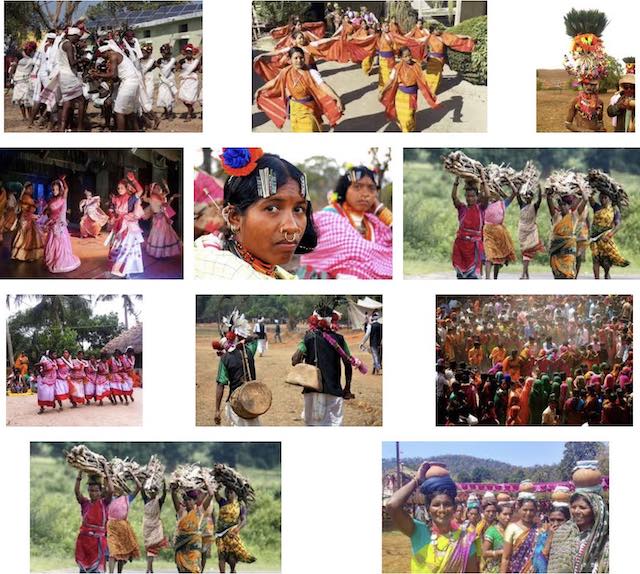
Anyone who has had some meaningful interaction with India’s indigenous or adivasi people, cannot fail to be touched by the encounter. There is a directness in them, an absence of artifice or guile, an almost childlike innocence, born of simplicity combined with a lack of greed and avarice. The more interior and untouched a village, the more unsullied the people. Unfortunately, this easily gets eroded when the outside world creeps in to contaminate them with its consumerist culture and worldly ways. Alcoholism, in every corner of the globe, has been the biggest factor in the downfall of indigenous people and in the decimation of their society. Nigerian author Chinua Achebe provided a perceptive insight into the disintegration of tribal society in Things Fall Apart. […]
Adivasi elders have complained of the loss of old ways and values, as the young move into modern clothes and emulate both filmstar heroes and non-tribal neighbours. Traditional adivasi garb has almost disappeared from younger people’s wardrobe. Women have switched to saris or salwar-kameez. There is a battle for adivasi souls between RSS-Hindutva (or Hindu nationalist) groups and Pentecostal Christians. Conversions, Christianising or Sanskritising, further alienate them from their roots and culture. Recently, there were discussions on whether the loss of tradition and culture is irreversible. Whether there is some hope of at least making kids aware of their heritage. A camp might do the trick, someone suggested. And so a series of children’s camps were organized to see what the kids might make of all these cultural questions. We were pleasantly surprised. The children trooped in, delighted to have a holiday. They enjoyed the tribal singing, dancing, food and company. But the turning point in every camp was the group discussion on adivasi and non-adivasi culture. The really surprising factor, considering the kids seem so non-adivasi now, speaking Tamil rather than their traditional languages, was that they had a strong awareness of their own culture and identity. […]
Unanimously and very vehemently, the children declared that ‘the adivasi way of life is better’. Their reasons: we try to find work close to our houses and villages, but non-adivasis go far away for jobs and money. The poor things have to leave their families and villages. Then, Gopalan, an adivasi facilitator said: ‘our bridegrooms pay a token gift to the bride’s family because women are valued’. Discussions ensued, on how women are viewed in the non-tribal society and the burden on families with daughters. ‘Our marriages are different,’ the kids announced. Why, we asked. ‘We don’t have dowry (or burn brides). We don’t wish only for boys and sons. We love daughters equally. Our wedding ceremonies are carried out by our elders, not by outsider priests or pujaris’. Very few kids had heard of female infanticide or sex-selective abortion. On learning what this meant, there was utter shock and disbelief on their faces. Unexpectedly, the kids also felt, ‘our gods are in our homes, our trees, our forests. They are always with us. But the neighbours must go to temples, churches or mosques. We are more dependent on nature for food. They go to shops more. We live as a community not as individuals. Sharing is part of our lives. The highlight of the camp was the walk through the Madhuvana (honey) forest. […]

“Is it eccentric to live in beautiful scenery in the hills among some of the most charming people in the country, even though they may be ignorant and poor?” – Verrier Elwin quoted by G.N. Devy in The Oxford India Elwin >>
In a farewell ritual, each child stood with eyes closed around a lamp lit by child representatives. The elders reminded them of all the things they learnt at the camp and planned to do after the camp. The stone would be kept carefully to remind them of their commitment and determination to protect their adivasi identity. We hope this is the beginning of a cultural revival.
#2 priya thomas 13 Jun 14
nice heartwarming article-the adivasi way of life seems almost utopian-one thing for sure we can certainly learn from them is how to treat our women folk better-no dowry deaths, female infanticide-I think many of our so called educated high caste Indians could take many a leaf from their books
#8 Stan 16 Jun 14
Responding to Priya’s comment about the adivasi way of life being almost utopian: I first came across adivasis as a student in the 1970’s when I attended a work camp in Bihar (now Jharkhand). A life changing experience that led me to make the adivasi cause more or less the focus of my life. Whenever I speak of the privilege of sharing in the lives of adivasi people on and off over the last 40 years or so – the most common reaction I get is that I am exaggerating, romanticising etc. Everyone is quick to point out that human beings are intrinsically selfish and greedy and you cannot have an entire society, an entire people who think differently. But guess what – you can! I have also had the privilege of being in villages of indigenous people in Kenya and Ethiopia and meeting and interacting with the first people of Australia and find among ALL these communities a common world view – one that is directly opposed to and in conflict with the majoritarian view that all of us non-adivasis assume is the norm! But this world view and its accompanying way of life is severely under threat as indigenous people all over the world are increasingly swamped and brought under the dominant world view. Their alternative voice is drowned out and if on rare occasions it is heard it is quickly derided. […]
Can this pride and strong identity see them into adulthood and enable them to make choices that are in keeping with their community’s world view? Or will they slowly inexorably become part of dominant society as Vinoth fears? I dont know. Only time will tell. I sincerely hope they hold on and in the meantime we will do all we can to help them do so. And say a prayer – may their tribe increase!
Source: “Glad to be adivasi!” by Mari Marcel Thekaekara, NewInt.org/blog, June 13, 2014 — New Internationalist
Address : https://newint.org/blog/2014/06/13/adivasi-indigenous-culture/
Date Visited: 21 April 2021
[Bold typeface added above for emphasis]
“The natural wealth with which much of tribal India is endowed is also its bane. […] The Adivasi is wedged between the state programme for development, meaning mines, dams, steel plants and roads, and a private agenda for quick money, which is currently termed ‘real estate’.” – Madhu Ramnath, Preface for Woodsmoke and Leafcups >>
“The practice of religious rituals, ceremonies and sanctions by specific cultural groups allow such sacred landscapes to be maintained, emphasizing that humans are intrinsically part of the ecosystem. Taboos, codes and customs specific to activities and community members restrict access to most sacred groves. […] The inclusion of local people’s needs and interests in conservation planning is increasingly accepted as essential, both to promote the well-being of human populations, and to ensure that biodiversity and conservation needs are met in the long-term.” – Nazir A. Pala, Ajeet K. Neg and N.P. Todaria in “The Religious, Social and Cultural Significance of Forest Landscapes in Uttarakhand Himalaya, India” (International Journal of Conservation Science, Vol. 5, Issue 2, April-June 2014) | Sacred groves | Biodiversity and development – Himalaya >>
If a man cannot enjoy the return of spring, why should he be happy in a labour-saving Utopia? … I think that by retaining one’s childhood love of such things as trees, fishes, butterflies and … toads, one makes a peaceful and decent future a little more probable, and that by preaching the doctrine that nothing is to be admired except steel and concrete, one merely makes it a little surer that human beings will have no outlet for their surplus energy except in hatred and leader worship.
George Orwell quoted in Two Cheers for Democracy (London: Penguin Books 1976), p. 76 | Learn more about Childhood | Childrens rights: UNICEF India | Safe search | Ecology and environment | Misconceptions | Modernity | Seasons and festivals | Social conventions >>
The house, in which British novelist George Orwell was born more than 110 years ago, has been converted into a museum by the Bihar Government >>

“[A] common perception of conversion, prevalent in India, is that all conversions take place only among deprived lower caste or tribal groups, which are considered more susceptible to allurement or coercion. The reality of upper caste conversions is ignored in this climate of cynicism.”– Dr. Ivy Imogene Hansdak in Pandita Ramabai Saraswati: the convert as ‘heretic’ | More about the effects of “casteism” >>
Tip: health and the nutritional value of indigenous grains, seeds and millets: “The tribal food basket has always been diverse and nutritious” >>
Up-to-date reports by Indian experts and journalists
Search tips
Combine the name of any particular state, language or region with that of any tribal (Adivasi) community.
Add keywords of special interest (music, poetry, dance just as health, sacred grove and biodiversity); learn about the rights of Scheduled Tribes such as the “Forest Rights Act” (FRA); and the United Nations “Declaration on the Rights of Indigenous Peoples”, “Universal Declaration of Human Rights”, “women’s rights”, or “children’s right to education”.
Ask a question that includes “tribal” or “Adivasi”, for instance: “Adivasi way of life better?” (or “tribal way of life worse?”)
Specify any particular issue or news item (biodiversity, bonded labour and human trafficking, climate change, ecology, economic development, ethnobotany, ethnomedicine, global warming, hunter-gatherers in a particular region or state, prevention of rural poverty, water access).
For official figures include “scheduled tribe ST” along with a union state or region: e.g. “Chhattisgarh ST community”, “Himalayan tribe”, “Scheduled tribe Tamil Nadu census”, “ST Kerala census”, “Particularly Vulnerable Tribal Group Jharkhand”, “PVTG Rajasthan”, “Adivasi ST Kerala”, “Adibasi ST West Bengal” etc.
In case the Google Custom Search window is not displayed here try the following: (1) toggle between “Reader” and regular viewing; (2) in your browser’s Security settings select “Enable JavaScript” | More tips >>
Note: hyperlinks and quotes are meant for fact-checking and information purposes only | Disclaimer >>
List of websites covered by this Google custom search engine
Academia.edu (platform for academics to share research papers) – www.academia.edu
Archive.org – https://archive.org
Centre for Science and Environment – https://www.cseindia.org
Current Conservation – https://www.currentconservation.org
Development and Cooperation (D+C) https://www.dandc.eu
Down To Earth (India) – www.downtoearth.org.in
India Environment Portal – www.indiaenvironmentportal.org.in
Harnessing Nature Magazine – https://harnessingnature.online
Mongabay-India – https://india.mongabay.com
M S Swaminathan Research Foundation – www.mssrf.org
Navdanya (protecting India’s biodiversity based food heritage) – https://navdanya.org
Third World Network (Penang, Malaysia) – https://twn.my
The Shola Trust (nature conservation in the Nilgiri region) – www.thesholatrust.org

Indian online periodicals and platforms | Images view >>
~ ~ ~
Personalize your CustomSearch by combining other search words >>
(e.g. name of a tribal community and region, a craft, or dance and puppetry)
Research the above issues with the help of Shodhganga: A reservoir of theses from universities all over India, made available under Open Access >>
Note: hyperlinks and quotes are meant for fact-checking and information purposes only | Disclaimer >>